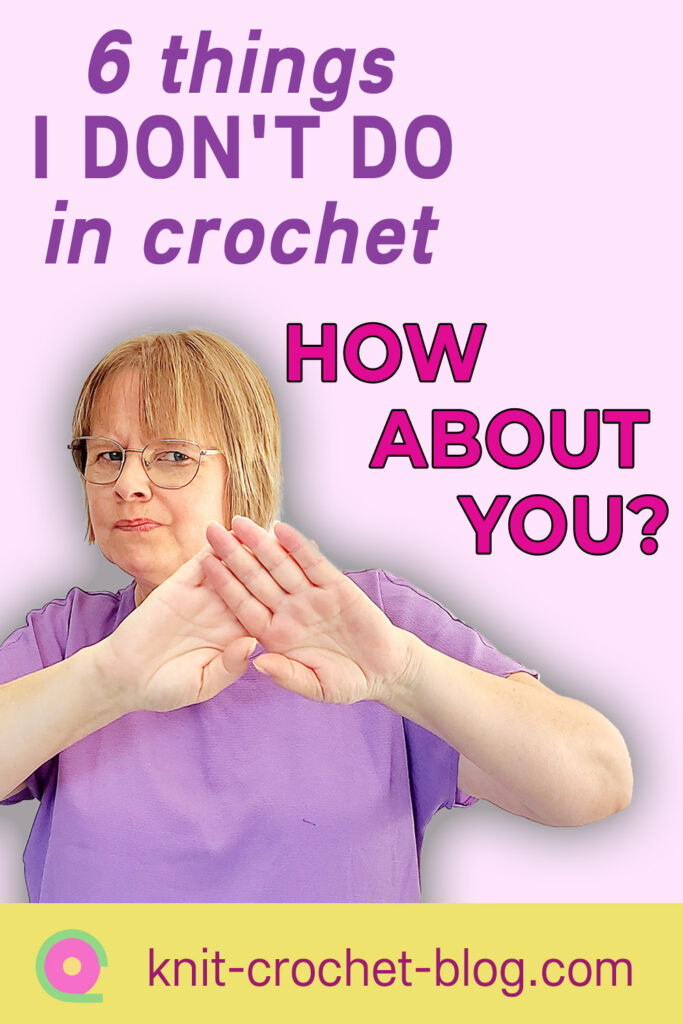Each crocheter has their own unique set of preferences and practices. I have been crocheting for well over 50 years. It is long enough to know what my preferences are! The video I created on this topic has sparked many interesting conversations. While some fellow crocheters agree with all or some of the points I’ve raised, others may hold contrasting views. Reading these can help you refine your own ideas and opinions.
With each of the points, I also mention an exception or two!
Watch the video where I go more in detail into each of the points.
This post contains affiliate links. It means that if you purchase a product I recommend, I may earn a small commission with no added cost to you.
1. Never knots in yarn
Never leaving or creating knots in yarn is what I learned as a child, both by my mother and at school craft classes. This has stuck with me, not wanting hard lumps in soft yarn. Also, it is hard to believe that a knot would hold in yarn, although there seem to be methods where it does. However, I have not tried those and will not try. I want all joins and finishes to keep the softness of yarn.
Instead of knots may weave ends in separately if the yarn is heavier. For medium weight and fine yarns, my favourite method is twisting the two yarns while continuing to crochet over the ends. See the method: Quick yarn join in crochet and knitting. No weaving in ends.
Exception: At times for large one-off pieces of crochet and knitting for yarnbombing projects outside, I may use knots to speed up the process. The pieces will normally be taken apart again after the vent so knots will be easier to cut off.
2. I don’t use acrylic yarn
Acrylic is plastic and lacks many of the qualities of natural fibers or mainly natural mixes. There is such a huge selection and choice of more natural yarns that I don’t see a reason to be needing acrylic for anything.
However, I’m not a puritanist as far as yarns go! I want wool sock yarns to have a small percentage of polyester or other fibers that strengthen wool. I love bamboo that needs a treatment to be made into yarn. Also wool is often easier to handle if it has a superwash finish.
I realise that in some countries it is easier to obtain acrylic than other fibers. Acrylic is also cheaper. If you have to use it, get the best quality ones!
Exception: I design for a crochet magazine. A few times they have sent me acrylic to work with so I had to use it.
3. I don’t skip making a gauge swatch before starting
This is quite self-explanatory. You waste a lot of time if you start a project and just guess what size the final result will be. Having to fix it, start again, be unsure.
Exception: If the size of the finished item doesn’t matter, then it is possible to skip swatching. These would be things like a scarf where the width may not matter.
4. I don’t crochet amigurumi
This is simply a personal preference, certainly nothing wrong with amigurumi! Some of them are super cute! Just not something I would enjoy making. I love using a combination of many stitches and textures, and especially having to stuff parts and sew or crochet parts together is just something I don’t want to spend my time on.
If you love amigurumi patterns, check out this colorful amigurumi site by Garnknuten.
5. I don’t start a ball of wool from the outside
If you start a ball of yarn from the outside, it will not stay where you put it. There are yarn bowls that can help. But still, it feels so much better to know that your yarn stays where you put it and the yarn runs smoothly without turning around.
If your yarn needs winding, use a good yarn winder and swift for holding the yarn. For small amounts, you can wind up a center-pull ball using only a wooden spoon or similar as a tool (video)
Exception: Very fluffy and furry novelty yarns or ones with sequence. They stick if you try to start from the inside.
6. I don’t use blunt needles for yarn
People often advise using a blunt needle for weaving in yarn ends or sewing crocheted or knitted pieces together. However, in my experience, this mostly is not the optimal choice. A sharp needle allows you to split the yarn easily while sewing instead of going round the yarns. This reduces the chances of the ends coming loose later on. You don’t need to sew too many times. You might hear recommendations to sew in three directions, but this is usually only necessary if the yarn is exceptionally slippery.
Exception: Chunky yarns may require a blunt needle if it shows a lot when you split the yarn.
Video “6 things I don’t do in crochet“
Pin the article to Pinterest:




Trackbacks/Pingbacks